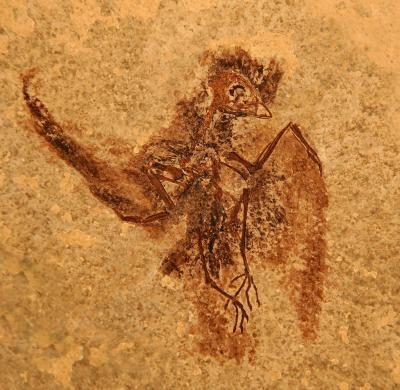A tiny fossil, the nearly complete skeleton of a bird that would have fit in the palm of your hand and weighed less than an ounce, offers clues to the precursors of swift and hummingbird wings. The fossil
discovered in Wyoming
is unusual in having exceptionally well-preserved feathers, which allowed the researchers to reconstruct the size and shape of the bird's wings in ways not possible with bones alone.
The paleontologists spotted the specimen, which was collected at the Green River Formation, while they were working at the Field Museum of Natural History in Chicago and named it Eocypselus rowei, in honor of John W. Rowe, Chairman of the Field Museum's Board of Trustees.
E. rowei lived roughly 50 million years ago, after the dinosaurs disappeared but before the earliest humans came to be and it was a tiny bird - only twelve centimeters from head to tail. Feathers account for more than half of the bird's total wing length.
To find out where the fossil fit in the bird family tree, the researchers compared the specimen to extinct and modern day species. Their analyses suggest that the bird was an evolutionary precursor to the group that includes today's swifts and hummingbirds.
Given the differences in wing shape between these two closely related groups of birds, scientists have puzzled over how swift and hummingbird flight came to be. Finding fossil relatives like this specimen is key to figuring that out, the researchers say.

Eocypselus rowei - evolutionary precursor to the group that includes today's swifts and hummingbirds. Photo contributed by Lance Grande of the Field Museum of Natural History
"This fossil bird represents the closest we've gotten to the point where swifts and hummingbirds went their separate ways," said lead author Daniel Ksepka of the National Evolutionary Synthesis Center in Durham, North Carolina.
Hummingbirds have short wings relative to their bodies, which makes them good at hovering in mid-air. Swifts have super-long wings for gliding and high-speed flight. But the wings of E. rowei were somewhere in between.
"[Based on its wing shape] it probably wasn't a hoverer, like a hummingbird, and it probably wasn't as efficient at fast flight as a swift," Ksepka said.
The shape of the bird's wings, coupled with its tiny size, suggest that the ancestors of today's swifts and hummingbirds got small before each group's unique flight behavior came to be. "Hummingbirds came from small-bodied ancestors, but the ability to hover didn't come to be until later," Ksepka explained.
Closer study of the feathers under a scanning electron microscope revealed that carbon residues in the fossils — once thought to be traces of bacteria that fed on feathers — are fossilized melanosomes, tiny cell structures containing melanin pigments that give birds and other animals their color. The findings suggest that the ancient bird was probably black and may have had a glossy or iridescent sheen, like swifts living today. Based on its beak shape it probably ate insects, the researchers say.
The other authors of this study were Julia Clarke, Sterling Nesbitt and Felicia Kulp of the University of Texas at Austin, and Lance Grande of the Field Museum of Natural History.
Published in the journal Proceedings of the Royal Society B.




Comments